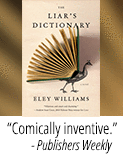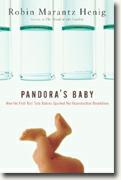Robin Marantz-Henig
book reviews:
· general fiction
· chick lit/romance
· sci-fi/fantasy
· graphic novels
· nonfiction
· audio books
· author interviews
· children's books @
curledupkids.com
· DVD reviews @
curledupdvd.com
newsletter
win books
buy online
links
home
for authors
& publishers
for reviewers

 |
Pandora's Baby: How the First Test Tube Babies Sparked the Reproductive Revolution Robin Marantz-Henig Houghton Mifflin Hardcover 256 pages February 2004 |
|
Imagine battling infertility for years – hoping, praying – anything to have the baby you so desperately desire. Then, imagine your doctor says that he can help you have that long-hoped-for child. There is a new procedure that can circumvent all those pesky reproductive problems that have been plaguing you.
That is just what happened to Doris and John Del-Zio in 1973. All they wanted was a child, but what they got was a place in debate over in vitro fertilization. Woven throughout Pandora’s Baby is the story of the Del-Zio’s heartbreaking, moving and precedent-making ordeal. At no other time could their struggle with infertility have made such headlines, becoming fodder for both sides of the scientific argument. While this real-life story is both poignant and evocative, it is only a portion of Pandora’s Baby. The author, Robin Marantz Henig, has chronicled every step of the scientific advancements, research experiments and controversies. She fairly shows both sides of the moral coin, and allows readers to draw their own conclusions. For the history, this book is worth the read, but there is another lesson lurking between the pages - one more relevant than you might first think. I’m talking about cloning. Yes, cloning and in vitro are relatively similar procedures, with only a few major differences. In fact, many of the same arguments made against cloning today are the carbon-copy diatribes of the in vitro debate, verbatim. And those same detractors were proven to be mere speculation by the further research of reproductive endocrinologist, scientists and the like. Imagine if they had not been allowed to continue studying the intricacies of human egg fertilization and embryonic development. For the couples that have gone on to have children courtesy of in vitro, that research has made all the difference in their lives. It has been said, that people are most afraid of what they cannot understand. The Civil Rights movement, the Woman’s Suffrage movement, and the Artificial Reproduction debate can be held as testaments to that fact. Pandora’s Baby offers up truth, facts and the pros and cons of in vitro and, by default, cloning. This book is ripe for readers who want to understand the scientific, moral and ethical arguments of genetic, reproductive, and biological developments. Although laden with medical and scientific techniques, this book is written for the average reader, in a clear, concise manner. I would recommend Pandora’s Baby to anyone interested in artificial reproduction, cloning, or the furthering of science. It is insightful, thought-provoking and very well written. © 2004 by Karen Pruitt Fowler for Curled Up With a Good Book |
|
|
|
 Click here to learn more about this month's sponsor! |
|
| fiction · sf/f · comic books · nonfiction · audio newsletter · free book contest · buy books online review index · links · · authors & publishers reviewers |
|
| site by ELBO Computing Resources, Inc. | |
 You are ecstatic. You begin the procedure and all goes well - until, that is, another doctor passes judgment on the procedure, calling it unethical, and essentially kills your developing embryo. You would sue, right?
You are ecstatic. You begin the procedure and all goes well - until, that is, another doctor passes judgment on the procedure, calling it unethical, and essentially kills your developing embryo. You would sue, right?